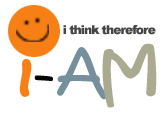I Think Therefore "I-AM"

"I-AM" who I know.
"I-AM" what I read.
"I-AM" where I am.
"I-AM" how I work.
"I-AM" me.
During a huge Australian Summer Storm on the 8th (and the subsequent black-out), Chris and I took the down-time to fine tune and clarify some of the details about the TouchStone Attention Engine.
It wasn’t like we were going to code anything.
During this conversation, Chris mentioned that TouchStone embodied Intuitive Attention Management or "I-AM". This initially was just a rather fancy nickname for the “How-Important-Is-It-Parser”, but the trouble is (despite my previous directives about what he was and wasn’t allowed to call the parsers) – I loved the name.
After arguing/talking about ways of defining and encapsulating the essence of what a user does and doesn’t want to be notified about, we settled on the idea that each and every item generated by a source (be it RSS or other), has a given relevance to the user at any given time. This relevance is based on a number of internal and external factors. By defining, naming and weighting these sources it’s possible to give each item an 'importance value' and then allow the user to define alert types based on value thresholds.
Further, we decided, we could encapsulate this functionality its own library so that other developers and their software can tap into its power.
The result is we take a source item, it's content, it's source, the author/publisher, key concepts/tags and apply pre-defined global and user defined “rules”. By biasing (positively or negatively) the final importance value, we can begin tuning the user experience based on relevancy.
After we fleshed out the specific details on how we would accomplish this, I-AM was born. An external class library with the methods by which we should be able to determine, intuitively, the value of a piece of content to a given user. The result of this calculation should be an ‘importance’ value that is attached to an item moving through the Touchstone system. This value is then used to determine the way in which an alert is presented (i.e. level of user interruption).

I love diagrams!
All values involved (we decided) should be from -5 to 5. A negative value being a vote against the relevancy of that item for the user. 1 being the least import, and 5 being the most.
With a growing number of Meme Engines out there, it is clear that there is an ongoing effort to try and reduce the RSS Overload and help content rise to the top. In essence, I-AM might be a personalized Meme engine that any feed reader could use to place a value of importance on content coming in from a user's OPML file (for example). It is then up to the news reader to determine how to act on that value for a great user experience.
I-AM is not intended to replace the existing attention ranking and suggesting methodologies, but merely to enhance the user’s ability to sort and control the flow of syndicated content on the client side.
Plus it has an awesome name - don't you agree?





0 Comments:
Post a Comment
<< Home